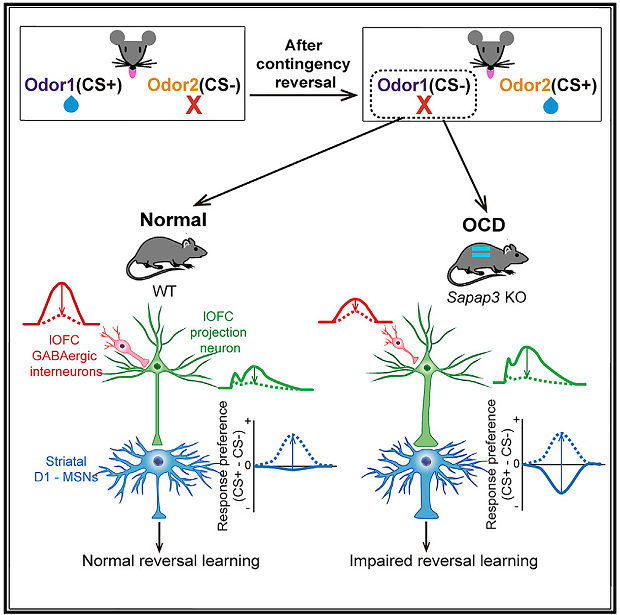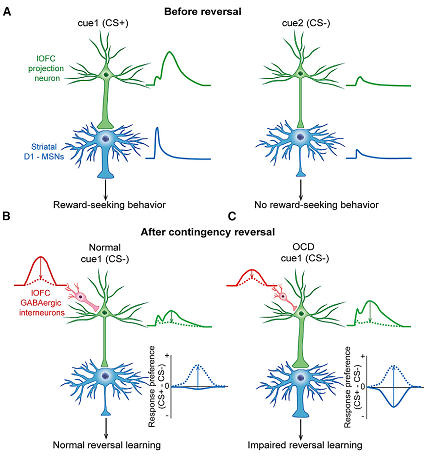AAV-GCaMP6m was used to investigate the cell-type-specific activity processes. AAV-hChR2 was used for optogenetic manipulation. (From
BrainVTA)
The viruses used in this article from BrainVTA are in the table below
|
Calcium sensors |
PT-0001 AAV2/9-CaMKIIa-GCaMP6m |
|
Optogenetic |
PT-0111 AAV-Ef1a-DIO-hChR2(H134R)-EYFP |
|
Control |
PT-0795 AAV2/9-Ef1a-DIO-EGFP |
Zicheng Yang, Geming Wu, Min Liu, Xiaohong Sun, Qunyuan Xu, Chen Zhang, Huimeng Lei
Pub Date: 2020-11-13,
DOI: 10.1016/j.cub.2020.10.045,
Email: sales@brainvta.com

Cognitive inflexibility is a cardinal symptom of obsessive-compulsive disorder (OCD) and often manifests as impaired reversal learning. Abnormal recruitment of the orbitofrontal cortex (OFC)-striatal circuit is implicated in reversal learning deficits in patients with OCD. However, the precise circuitry mechanism underlying normal and impaired reversal learning remains elusive. Using fiber photometry and optogenetics, we demonstrated cell-type-specific activity dynamics in the OFC-striatal circuit underlying normal reversal learning and cell-type-specific dysfunctions that causally lead to impaired reversal learning in an OCD mouse model (Sapap3 knockout mice). After contingency reversal, OFC GABAergic interneurons increase the activity in response to previously rewarded but currently non-reward cues to inhibit the elevated activity of OFC excitatory neurons encoding inappropriate cue-reward association. Striatal direct-pathway medium spiny neurons (D1-MSNs) gradually re-establish their response preference for rewarded versus non-reward cues. These activity dynamics together mediated normal reversal learning. In Sapap3 knockout OCD mouse model, the increase in activity of OFC GABAergic interneurons in response to previously rewarded but currently non-reward cues after contingency reversal was reduced, which resulted in insufficient inhibition on OFC excitatory neurons, which in turn led to a more severe inversion of the response preference of D1-MSNs for rewarded versus non-reward cues, ultimately resulting in slower reversal learning. These dysfunctions were causally involved in reversal learning impairments. Our findings identified OFC GABAergic interneurons as the key therapeutic target to treat cognitive inflexibility in OCD and may be generally applicable to cognitive inflexibility in other neuropsychiatric disorders.
 Figure 1. Potential Circuitry Mechanisms Underlying Reversal Learning in Normal and OCD Conditions.
Figure 1. Potential Circuitry Mechanisms Underlying Reversal Learning in Normal and OCD Conditions.
This study is aimed to explore the precise circuitry mechanism underlying normal and impaired reversal learning. Combining fiber photometry and optogenetics, the authors investigated (1) how activity dynamics of different neuronal types in the OFC-striatal circuit orchestrate normal reversal learning in wild-type (WT) mice, (2) examined cell-type-specific activity alterations in the OFC-striatal circuit underlying reversal learning impairments in Sapap3 KO mice, and (3) established the causal role of these dysfunctions in reversal learning impairments. This data would advance our understanding on the mechanisms of disrupted cognitive aspects of these diseases.
BrainVTA offers viral vector construction & virus packaging services for AAV, LV, RABV, PRV, HSV and VSV that help researchers explore questions about genes, neurons, circuitry structure, function of brain network, mechanism and treatment of diseases.
If you have any needs, just email us at
sales@brainvta.com.

